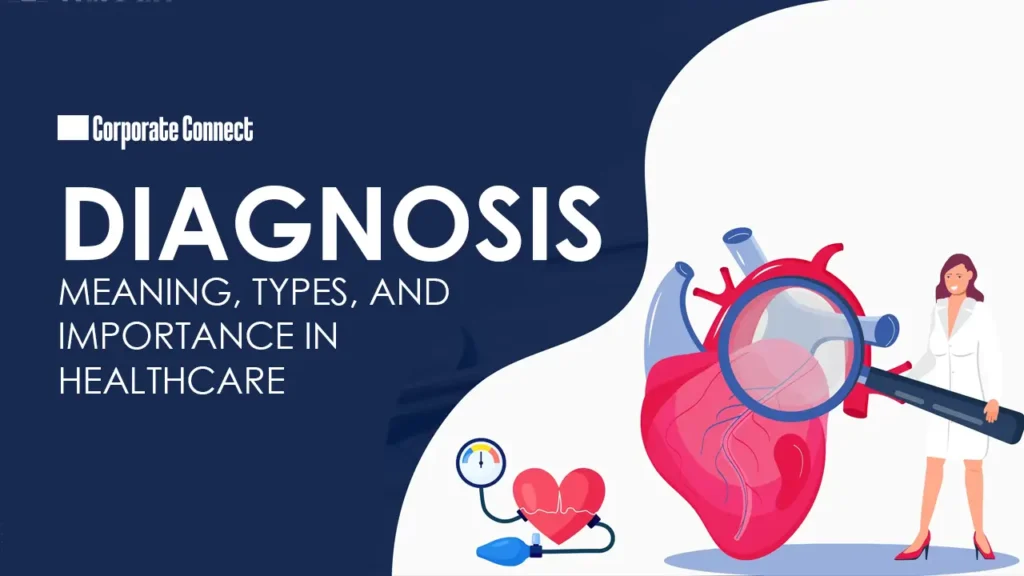Diagnosis: Meaning, Types, and importance in healthcare
Written By Jaya Pathak
In healthcare, diagnosis is where uncertainty gives way to direction. It is the discipline work to figure out what best explains the symptoms, examination findings and test results of a person. Afterwards, it is named clearly so that treatment can be preceded with purpose. In everyday practice, diagnosis can be used as both a method and a decision. It is basically a stepwise inquiry which narrows possibility and finally label the therapy, records risk and supports reimbursements.
What diagnosis involves
A reliable diagnosis rarely arrives in one leap. It begins with the story—when the problem started, what aggravates it, what eases it, which risks are present, how the pattern has shifted. A focused examination follows, then targeted tests chosen not for volume but for their ability to shift the odds between competing explanations. If you are arriving to a conclusion quite early then it is considered as provisional. When the new findings come up, the picture is redefined. The label that remains is more than a word in a chart; it sets treatment, frames expectations, and feeds coding and analytics that keep the system accountable.
Why it matters—for patients and systems
- Clinical impact: It is quite important for patients as well as system as once you will get the right name then you can proceed to the right therapy period it will not only shorten the time recovery but also avoid any harmful activity. It also makes prognosis conversations honest and useful.
- Financial and operational value: Clear definitions reduce redundant testing and low‑value procedures, align payment with the true level of illness, and lower avoidable readmissions.
- Reliability and trust: Standardized diagnoses support benchmarking, staffing plans, and capacity management. When the reasoning is documented well, patients understand the plan and are more likely to follow it.
The main types, in plain terms
- Clinical diagnosis: Reached mostly from history and examination when the pattern is classic and action cannot wait.
- Differential diagnosis: A ranked list of plausible causes considered at the start and revised as evidence arrives; this is the safeguard against premature closure.
- Working (provisional) diagnosis: The best current explanation used to start care while confirmatory results are pending.
- Definitive (confirmed) diagnosis: It is secured by some gold standard proof such as biopsy and other unmistakable imaging.
- Syndromic diagnosis: It is done for patient labeling such as acute coronary syndrome. It can trigger urgent protocols by clarifying the exact cause.
- Etiologic diagnosis: This type of diagnosis enables pressures and therapy and public health action.
- Anatomical/stage diagnosis: It helps to locate and tell the extent of disease. Afterwards the procedure choice is made by determining prognosis and trial eligibility.
How rigorous diagnosis is made
- Listen first: Pin down the timeline, exposures, medicines, family patterns, and red flags; small details often carry the most weight.
- Examine with intent: Look for signs that separate one cause from another rather than confirm what is already likely.
- Test to change probability: Choose studies that genuinely move the odds; use sensitive tests to rule out danger and specific tests to confirm what will trigger treatment.
- Interpret in context: Combine pre‑test likelihood with test performance; do not overreact to a single abnormal number or an incidental image finding.
- Reassess and close the loop: Reconcile conflicts in the data, write down the reasoning, and set conditions for revisiting the conclusion if the picture changes.
Frequent pitfalls—and sensible safeguards
- Vague early symptoms: Many illnesses start nonspecifically. Use structured histories, brief decision aids, and clear return instructions to catch deterioration early.
- Cognitive traps: Anchoring and early closure skew judgment. Short checklists, second opinions for high‑risk cases, and brief “diagnostic timeouts” improve reliability.
- Fragmented information: Siloed records and rushed handovers hide key facts. Interoperable systems, confirmed result acknowledgment, and shared care plans keep teams aligned.
- Overdiagnosis and incidentalomas: Some sensitive tests reveal harmless anomalies. You can use shared decision making to avoid any the sort of low value care. You can agree on action thresholds as well.
- Equity gaps: If you want to access any barrier delay recognition in underserved groups then it can be helpful for you. It can provide culturally competent care and targeted screening narrow disparities.
Documentation, coding, and data quality
Good notes translate clinical thinking into standardized codes that drive reimbursement and public reporting. A clear designation of principal versus secondary diagnosis can be provided which can explicitly link the complications as well as underlying conditions of the patient. You can be timely updated to the problem list which can protect revenue integrity and allow the fair comparison across different institutions. You can also collaborate between various clinics and coding specialist as it can reduce denials and boost audit readiness.
Tools that help—when used well
There are various tools in the market which can really help if it is used well. This isn’t support, point of care ultrasound, Genomics and data-driven triage can really help to sharpen the diagnosis when it is included into the workflow. The greatest value comes from augmentation: tools that surface red flags, organize information, and prompt reconsideration of alternatives. Human judgment remains essential for nuance, ethics, and honest discussion of uncertainty.
Making diagnosis a safety priority
Treat diagnosis as a core safety domain. Track time‑to‑diagnosis for sentinel conditions, review delays and near misses, and route lessons back to frontline teams. Standardized handoffs, multidisciplinary case reviews, and clear escalation steps for unresolved uncertainty improve reliability, experience, and risk posture.
Priorities for healthcare leaders
– Protect the fundamentals: Ensure time for history and examination; integrate decision support where it genuinely improves choices.
– Close the follow‑up loop: Make responsibility for reviewing results explicit, and give patients clear next steps and safety‑net advice.
– Measure what matters: Monitor diagnostic intervals, revision rates after discharge, and equity‑sensitive indicators; align incentives with improvement.
– Build capability: You can be taught structured reasoning along with cognitive debiasing. It can help to recognize diagnostic excellence as a core professional skill.
– Engage patients as partners: Plain and simple language can be used so that you can really engage with patients as partners. You must acknowledge uncertainty if it exists and tailor the scope of testing to personal values and risk.
Conclusion
In a nutshell, diagnosis can really turn ambiguity into coordinated action. When clinics and organizations boost diagnostic quality then they do not simply deliver better care but also even public confidence and use resources wisely. All such factors stand as the benchmark of a resilient and high-performance system.










